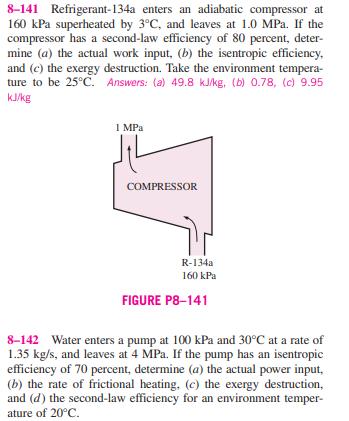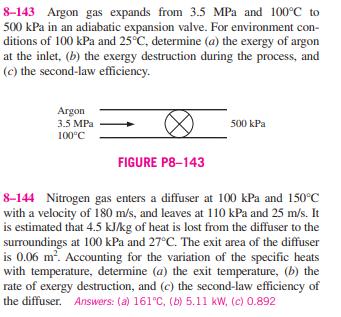Answered step by step
Verified Expert Solution
Question
1 Approved Answer
8-141 Refrigerant-134a enters an adiabatic compressor at 160 kPa superheated by 3C, and leaves at 1.0 MPa. If the compressor has a second-law efficiency



8-141 Refrigerant-134a enters an adiabatic compressor at 160 kPa superheated by 3C, and leaves at 1.0 MPa. If the compressor has a second-law efficiency of 80 percent, deter- mine (a) the actual work input, (b) the isentropic efficiency, and (c) the exergy destruction. Take the environment tempera- ture to be 25C. Answers: (a) 49.8 kJ/kg, (b) 0.78, (c) 9.95 kJ/kg 1 MPa COMPRESSOR R-134a 160 kPa FIGURE P8-141 8-142 Water enters a pump at 100 kPa and 30C at a rate of 1.35 kg/s, and leaves at 4 MPa. If the pump has an isentropic efficiency of 70 percent, determine (a) the actual power input, (b) the rate of frictional heating, (c) the exergy destruction, and (d) the second-law efficiency for an environment temper- ature of 20C. 8-143 Argon gas expands from 3.5 MPa and 100C to 500 kPa in an adiabatic expansion valve. For environment con- ditions of 100 kPa and 25C, determine (a) the exergy of argon at the inlet, (b) the exergy destruction during the process, and (c) the second-law efficiency. Argon 3.5 MPa 100C 500 kPa FIGURE P8-143 8-144 Nitrogen gas enters a diffuser at 100 kPa and 150C with a velocity of 180 m/s, and leaves at 110 kPa and 25 m/s. It is estimated that 4.5 kJ/kg of heat is lost from the diffuser to the surroundings at 100 kPa and 27C. The exit area of the diffuser is 0.06 m. Accounting for the variation of the specific heats with temperature, determine (a) the exit temperature, (b) the rate of exergy destruction, and (c) the second-law efficiency of the diffuser. Answers: (a) 161C, (b) 5.11 kW, (c) 0.892 8-145 Heat is lost through a plane wall steadily at a rate of 800 W. If the inner and outer surface temperatures of the wall are 20C and 5C, respectively, and the environment temper- ature is 0C, the rate of exergy destruction within the wall is (b) 17,500 W (a) 40 W (d) 32,800 W (e) 0 W (c) 765 W
Step by Step Solution
There are 3 Steps involved in it
Step: 1

Get Instant Access to Expert-Tailored Solutions
See step-by-step solutions with expert insights and AI powered tools for academic success
Step: 2

Step: 3

Ace Your Homework with AI
Get the answers you need in no time with our AI-driven, step-by-step assistance
Get Started


